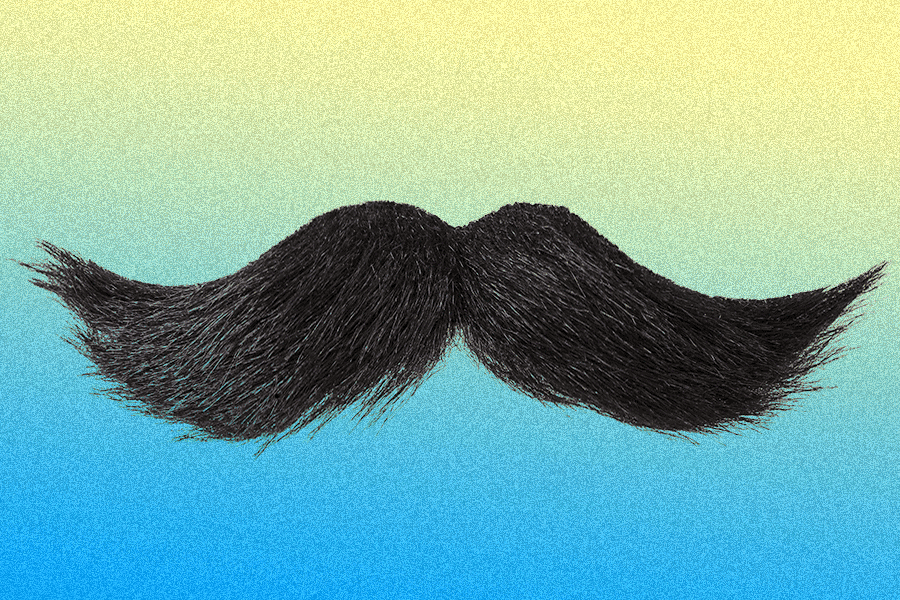Quick thought experiment: Close your eyes and, in the hairiest part of your mind, try to picture the most iconic beards from history.
Done?
Odds are, you’ll have been imagining an assortment of upstanding, wise gentlemen — the likes of Charles Darwin, Santa Claus, Abraham Lincoln, Dumbledore.
Now try the same sort of whiskers visualization with mustaches.
What do you get?
Adolf Hitler and Joseph Stalin, every time.
For some reason, mustaches make us reach straight for the villains. But what about all the famous ’stache-toters who have had a positive influence on the world: Einstein? Gandhi? Martin Luther King? John Oates from Hall & Oates?
There’s clearly some sort of facial prejudice going on here, because while full beards have been warmly accepted by fashion and society at large for a decade or more now, mustaches on their own have been sneered at as second-class frizz for far, far longer than most of us have been able to grow one.
According to Lucinda Hawksley, art historian and author of Moustaches, Whiskers and Beards — who happens to be a great-great-great-granddaughter of the fantastically whiskered Charles Dickens — the fact that the mustache was “hijacked by the dictators” actually had a huge historical impact on above-the-mouth fashions. Whereas in the 1930s, the elegant lip-strips of silver-screen stars like Clark Gable, Errol Flynn and Ronald Colman had bestowed glamor, prestige and enormous popularity upon the mustache, says Hawksley, its associations with both Nazi Germany and Soviet Russia made the thought of wearing one feel decidedly less dashing in the decades following World War II.
Still, for all that the Führer’s trademark toothbrush mustache and Uncle Joe’s walrus style in particular suffered by association, the ’stache remained a viable option in other guises for men interested in projecting an image of rugged machismo. This reached an apex of billowing perfection in the early 1980s with Tom Selleck as Magnum P.I. But for Hawksley, this was also the decade in which the mustache categorically lost its luster across the board. After that, she says, Selleck “still managed to have a moustache and carry it off, but for pretty much everybody else, it was completely outdated.”
Hawksley believes there were two main reasons for this. The first was the advent of designer stubble: “That became the big thing,” she says. “So, suddenly, instead of having a mustache and no beard you’d have a small amount of both.” The second is a recurring theme she sees in evidence “throughout the history of men’s facial hair: It’s that the younger generation wants to do the opposite of what their fathers had done. In the late-Victorian period, for example, by the 1890s, you’ve got young men saying, ‘I’m not having a beard — my dad and my grandfather had beards, and they’re just completely old-fashioned.’ And that’s exactly what happened in the 1980s: ‘Oh my God, a mustache! That’s such a 1970s look!’”
At around that time, though, something else was undermining the status of the mustache as the height of heterosexual manliness. In his book One Thousand Beards, Allan Peterkin (who has been a mustache consultant for Jimmy Fallon) points to Selleck’s 1980s thicket as one of the last great American specimens, too. But he argues that Magnum also represented a mainstream, TV-friendly offshoot of a popular gay look of the era: “The so-called ‘clone,’ with his obligatory mustache, bomber jacket, beefed-up shoulders and muscular butt under tight jeans.”
This Freddie Mercury-esque “clone” look had evolved in turn, writes Peterkin, from the subculture of “leathermen” in the gay clubs of the 1970s, whose “sadomasochistic practises and role-playing flourished and became a new homoerotic norm. The look was hypermasculine,” he continues. “Think Tom of Finland iconography — and both mustaches and sideburns topped (and bottomed) it off.”
Peterkin also highlights the Village People, whose stage routines for hits such as “Y.M.C.A.” and “Go West” featured both a leatherman and a mustachioed cowboy, helping to make Middle America aware of the mustache’s prominent status in gay culture.
https://www.youtube.com/watch?v=Uhn6KduyJHw
Perhaps equally devastating for the ’stache’s popularity in straight society was the running joke in the first four Police Academy movies — from 1984 to 1987 — in which hapless male characters find themselves trapped in a fictional gay club, the neon-lit Blue Oyster Bar, where they’re forced to dance with fuzzy-lipped leathermen. It was an increasingly unfunny gag, which simultaneously managed to entrench a daft homophobic stereotype and torpedo the mustache as a macho status symbol for straight men.
What really made mustaches utterly unwearable, though, wasn’t so much their association with gay and S&M subcultures but that — as epitomized by those Blue Oyster skits — they became the subject of ridicule. Hawksley points out that when “it stopped having that macho look about it, the man with the mustache became a bit of a joke. It was the bank manager, the annoying teacher…”
If the mustache’s appeal was entirely wrapped up with its machismo, how did it acquire its super-manly image in the first place? For Hawksley, the answer lies in its surprisingly important place in military history. Facial hair initially became a trend thanks to British soldiers fighting the Crimean War in the mid-1850s. Says Hawksley: “It was the first time they’d ever been able to grow a beard in the army, simply because they hadn’t been able to shave — the shaving water would freeze; they didn’t have enough shaving soap… And so when they came back, it was the sign of a hero because the Crimean War was so widely publicized.”
Elaborate face topiary acquired a similar heroic status during the American Civil War in the following decade, with the U.S. Army having relaxed its outright ban on mustaches (except for soldiers serving in the cavalry regiments) in 1857. In military traditions on both sides of the Atlantic, full beards quickly gave way to mustaches as the mark of a whiskered warrior. Incredibly, while beards were banned from 1860 onwards, the British Army actually required all soldiers to grow mustaches until World War I; after that, they became associated with the higher ranks, especially in the Royal Air Force.
Even today, while U.S. Army regulations outlaw beards, mustaches are permitted as long as they “will not present a chopped off or bushy appearance, and no portion of the mustache will cover the upper lip line, extend sideways beyond a vertical line drawn upward from the corners of the mouth… or extend above a parallel line at the lowest portion of the nose.”
Hawksley applauds the mustache’s tentative return to fashion in recent years, which she attributes to Movember, the annual sprouting of sponsored lip shrubs to raise awareness of men’s health issues. “The fashionistas on the street started to grow mustaches and not just for Movember,” she says. “They’d grow one and then think, Oh, I quite like it. But the real hipster mustache — the Hercule Poirot, Edwardian-style mustache, which is waxed and shaped in a certain way — that’s really fashionable now.”
But in reviving the mustache as an ironic prank, hasn’t Movember consigned it to kitsch for all eternity? “I think the whole idea of the kitsch mustache is deeply fashionable,” counters Hawksley. “It’s worn proudly with ironic collusion. The irony is the whole point of it.”
While we might think of ironic hipster face-fuzz as a recent phenomenon, the idea of the mustache as a guerrilla fashion statement, worn with an air of knowing self-parody, goes back much further than we realize — something Hawksley understands better than most. Her great-great-great grandfather, Charles Dickens, was a pioneer for Victorian-era facial hair, and in the 1840s, long before he developed his famous long, “door-knocker” beard, he began his whiskery experiments with mustaches.
“He had a competition about growing a mustache with his friend, the artist Daniel Maclise,” explains Hawksley. “Most of his friends and family absolutely hated it.” In a letter to Maclise in 1844, at a time when facial hair of any stripe was deeply unfashionable, Dickens summed up his feelings about his recent dalliances with top-lip drapery: “The mustaches are glorious, glorious. I have cut them shorter, and trimmed them a little at the ends to improve their shape. They are charming, charming. Without them, life would be a blank.”

